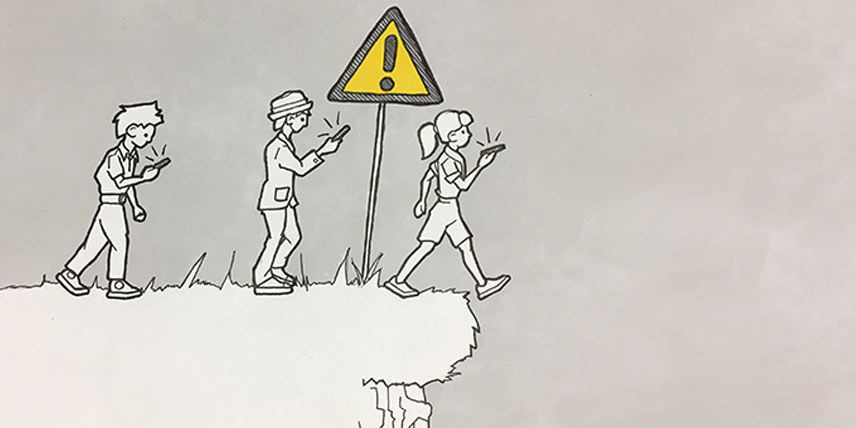Digital welfare and e-safety for learners
- Sophia Mavridi
- Currently working on digital literacy projects … read more
-


Effective use of technology can revolutionise language learning and teaching allowing us to connect and share beyond the boundaries of the classroom. However, as well as increasing learning opportunities, it can also present very real and serious risks for the uninformed (Becta, 2005). A challenge for educators, therefore, is how to increase their learners’ learning opportunities without promoting potential risks associated with internet use.
Online risks
There are certain characteristics of digital technologies that can introduce new risks to young people, such as easy access for users as well as ‘visibility’ and ‘searchability’ of what they have shared (Boyd, 2014). Below are some of the most prevalent risks that young people might face when they are online:
- privacy risks
- negative digital footprint
- exposure to inappropriate content
- false information
- digital distractions
- digital plagiarism
- commercial exploitation
- identity theft
- cyber-bullying
- sexual solicitation and grooming
- spam and malware.
Does the above list overwhelm you? Does it make you think that technology might do more harm than good? Do you, as an educator, want to be part of the solution but don’t know what this is?
According to specialists, banning or constant safeguarding are not effective long-term solutions. You can ban access to the internet while in the classroom or at home, but will you be able to control access beyond that? A growing body of research suggests that one of the main objectives for teachers should be to increase learners’ resilience to online risk. This involves providing them with opportunities to access the powerful benefits of the internet while at the same time empowering them with skills and competences to be risk aware and risk resilient (Collier and Nigam, 2010; Livingstone et al, 2011). Byron (2008: 2) powerfully depicts this with the following analogy:
‘At a public swimming pool we have gates, put up signs, have lifeguards and shallow ends, but we also teach children how to swim.’
Empowering learners
Addressing digital welfare and e-safety is, therefore, essential to helping learners learn, create, communicate and collaborate safely and responsibly online. Below are some of the topics we need to integrate:
- privacy
- netiquette
- digital ethics
- digital footprint
- digital welfare
- critical thinking skills
- digital distractions
- recognising malware.
Empowering learners to use technology safely and responsibly is not an easy task nor a once-and-for-all approach. Here are some guidelines to help you implement the skills above:
- Start teaching these skills to very young learners and include them every year through high school or college. Choose age-appropriate topics and introduce them in an age-appropriate way. Young learners might need to start from netiquette while teens from digital distractions. Like me, you may realise that some of your young adults plagiarise or cannot evaluate the credibility of online content so you might decide to help them develop these skills first.
- Vary the time you spend depending on learners’ age, school curriculum and class dynamics. As a language teacher, always look out for opportunities to develop language skills as well. You can spend a few minutes of class time on any one topic, e.g. a group discussion on digital distractions (5 minutes), or a video on online privacy followed by a group discussion (10 minutes); or spend an entire class on individual topics, e.g. recognising false information (a warm-up discussion, reading, hands-on activity and feedback).
- Avoid scare tactics, punishment or restrictions. Instead, present them with the problem and invite them to research and come up with their own informed solutions. As Gallagher (2016) suggests regarding digital distractions, ‘instead of calling out students who are distracted by taking their device away, teach them how they can manage the entertainment part of technology with the academic or professional part of it.’
Remember: ‘To youth, social media and technologies are not something extra added onto their lives; they’re embedded in their lives.’ (Collier and Nigam, 2010: 5) We need to embrace technology and show learners how to make their digital lives safe and fulfilling.
References
Becta (2005) E-safety: Developing whole-school policies to support effective practice, British Educational Communications and Technology Agency.
Boyd, D (2014) It’s Complicated: The Social Lives of Networked Teens, New Haven: Yale University Press.
Byron, T (2008) Safe Children in a Digital World: The report of the Byron Review, The UK Department for Education.
Collier, A and Nigam, H (2010) Youth Safety on a Living Internet. Report on the Online Safety and Technology Working Group.
Gallagher, K (2016) The Importance of Digital Citizenship in Today’s Classrooms. Showbie [blog post].
Livingstone, S, Haddon, L, Görzig, A, and Ólafsson, K (2011) Risks and safety on the internet: The perspective of European children (Full Findings) LSE, London: EU Kids Online.
